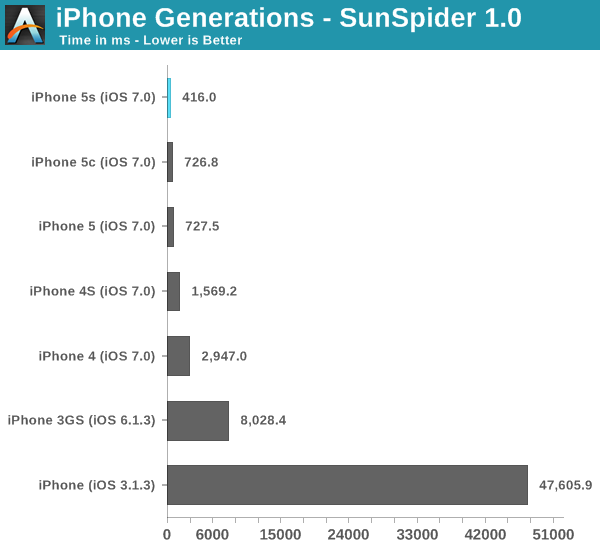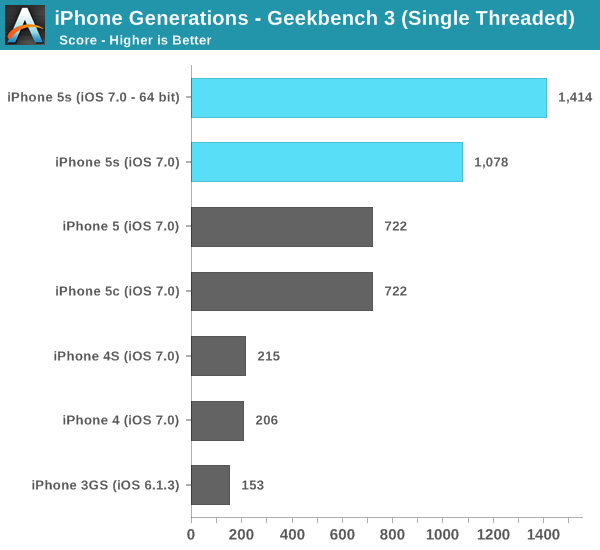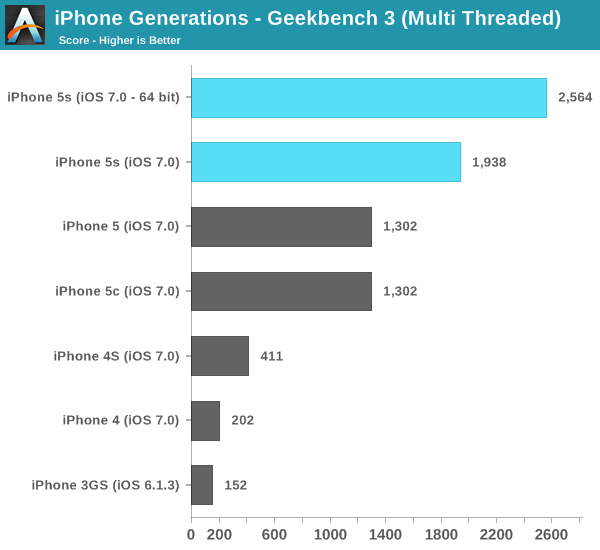The iPhone 5s Review
by Anand Lal Shimpi on September 17, 2013 9:01 PM EST- Posted in
- Smartphones
- Apple
- Mobile
- iPhone
- iPhone 5S
iPhone Performance Across Generations

Performance improved by a factor of 100x compared to the original iPhone. You can cut that in half if the iPhone could run iOS 4. Needless to say, Apple's CPU performance estimates aren't unreasonable. We've come a long way since the days when ARM11 cores were good enough.
Even compared to a relatively modern phone like the iPhone 4, the jump to a 5s is huge. The gap isn't quite at the level of an order of magnitude, but it's quickly approaching it. Using the single core iPhone 4 under iOS 7 just feels incredibly slow. Starting with the 4S things get a lot better, but I'd say the iPhone 4 is at the point now where it's starting to feel too slow even for normal consumers (at least with iOS 7 installed).

Browsermark 2.0 gives us a good indication of less CPU bound performance gains. Here we see over a 5x increase in performance compared to the original iPhone, and an 83% increase compared to the iPhone 4.
I wanted to have a closer look at raw CPU performance so I turned to Geekbench 3. Unfortunately Geekbench 3 won't run on anything older than iOS 6, so the original iPhone bows out of this test.

Single threaded performance scaled by roughly 9x from the 3GS to the iPhone 5s. The improvement since the iPhone 4/4S days is around 6.5x. Single threaded performance often influences snappiness and UI speed/feel, so it's definitely an important vector to scale across.

Take into account multithreaded performance and the increase over the 3GS is even bigger, almost 17x now.
The only 3D test I could get to reliably run across all of the platforms (outside the original iPhone) was Basemark X. Again I had issues getting Basemark X running in offscreen mode on iOS 7 so all of the tests here are run at each device's native resolution. In the case of the 3GS to 4 transition, that means a performance regression as the 3GS had a much lower display resolution to deal with.

Apple has scaled GPU performance pretty much in line with CPU performance over the years. The 5s scores 15x the frame rate of the iPhone 4, at a higher resolution too.
iPhone 5s vs. Bay Trail
I couldn't help but run Intel's current favorite mobile benchmark on the iPhone 5s. WebXPRT by Principled Technologies is a collection of browser based benchmarks that use HTML5 and js to simulate a number of workloads (photo editing, face detection, stocks dashboard and offline notes).

Granted we're comparing across platforms/browsers here, but the 5s as a platform does extremely well in Intel's favorite benchmark. The 5c by comparison performs a lot more like what we'd expect from a smartphone platform. The iPhone 5s is in a league of its own here. While I don't expect performance equalling the Atom Z3770 across the board, the fact that Apple is getting this close (with two fewer cores at that) is a testament to the work done in Cupertino.
At its launch event Apple claimed the A7 offered desktop class CPU performance. If it really is performance competitive with Bay Trail, I think that statement is a fair one to make. We're not talking about Haswell or even Ivy Bridge levels of desktop performance, but rather something close to mobile Core 2 Duo class. I've broken down the subtests in the table below:
| WebXPRT Performance (time in ms, lower is better) | ||||||
| Chrome/Mobile Safari | Photo Effects | Face Detection | Stocks | Offline Notes | ||
| Apple iPhone 5s (Apple A7 1.3GHz) | 878.9 ms | 1831.4 ms | 436.1 ms | 604.6 ms | ||
| Intel Bay Trail FFRD (Atom Z3770 1.46GHz) | 693.5 ms | 1557.0 ms | 542.9 ms | 737.3 ms | ||
| AMD A4-5000 (1.5GHz) | 411.2 ms | 2349.5 ms | 719.1 ms | 880.7 ms | ||
| Apple iPhone 5c (Apple A6 1.3GHz) | 1987.6 ms | 4119.6 ms | 763.6 ms | 1747.6 ms | ||
It's not a clean sweep for the iPhone 5s, but keep in mind that we are comparing to the best AMD and Intel have to offer in this space. I suspect part of why this is close is because both of those companies have been holding back a bit (there's no rush to build the fastest low margin parts), but it doesn't change reality.










464 Comments
View All Comments
Srinij - Thursday, September 19, 2013 - link
We need to include the Xiaomi Mi3 when its out, its touted as the fastest.koruki - Thursday, September 19, 2013 - link
Some test show its slower than a Samsung S3Shadowmaster625 - Thursday, September 19, 2013 - link
Who wants to bet that we will see a 10x increase in the number of robberies that involve limb amputation over the next 5 years?dugbug - Thursday, September 19, 2013 - link
you think its easier to remove a finger from someone than threatening them to unlock their phone (which could be done with any pascode-based phone). Really. Jesus.koruki - Thursday, September 19, 2013 - link
I'll take that bet."But Apple promises that its reader can sense beyond the top layer of a user’s skin, and includes a “liveness” test that prevents even a severed finger from being used to access a stolen phone."
http://www.forbes.com/sites/andygreenberg/2013/09/...
hasseb64 - Thursday, September 19, 2013 - link
MEH, Iphone 5x main problems:-Small battery
-Screen to narrow, need 5mm width
Fix this Apple and you maight get a new deal here
nitemareglitch - Thursday, September 19, 2013 - link
Still my number one site for deep dives on hardware. As always, you do NOT disappoint. I am going to upgrade now! You convinced me. I am sold.av13 - Thursday, September 19, 2013 - link
Anand, thanks a lot. Having worked with IBM iSeries systems since 2000 - RS65 III or iStar and now Power systems I was stunned when techies and investors alike were shrugging off Apple's transition to 64 bit. The fact that the A7 is RISC based and 64 bit its performance is going to show in single threaded and multi-threaded apps. It was even funny when some experts quipped that the 5s has to have at least 4 GB for the 64 bit to make sense. I was very encouraged that at least Apple decided on this roadmap.Great analysis by you - as usual - Yawn!
petersterncan - Thursday, September 19, 2013 - link
I would really like to see how these phones stack up against the Blackberry Z10, Q10 and Z30.Are you considering reviewing those any time soon?
ScottMinnerd - Thursday, September 19, 2013 - link
Please excuse my ignorance, but can someone please explain how a JS-based benchmark is any indication of the quality of a CPU?There's so much abstraction between JS code and the CPU registers that you might as well benchmark the performances of a Ferarri vs. a school bus while they're driving over mattresses and broken glass respectively. On the same browser on the same operating system on the same motherboard using the same RAM and the same bus architecture, yes, JS code could give a relevant basis for comparison of CPUs.
Also, does the included iOS browser have a multi-threaded JS engine? Does the Android's?
If one were to run 4 or 8 instances of the benchmark test simultaneously, how would each instance perform on each device having each CPU? Would the metric be higher on the 4+ core devices?
If Apple is leveraging a multithreaded JS engine, or a 64-bit optimized JS engine (or both), then the quality of the CPUs depends upon a given workload. The workload on a phone in the real world is rarely solely JS-based. Testing the performance of JS and then implying that the iPhone (or its CPU) is superior in general is not only misleading, but toadying.